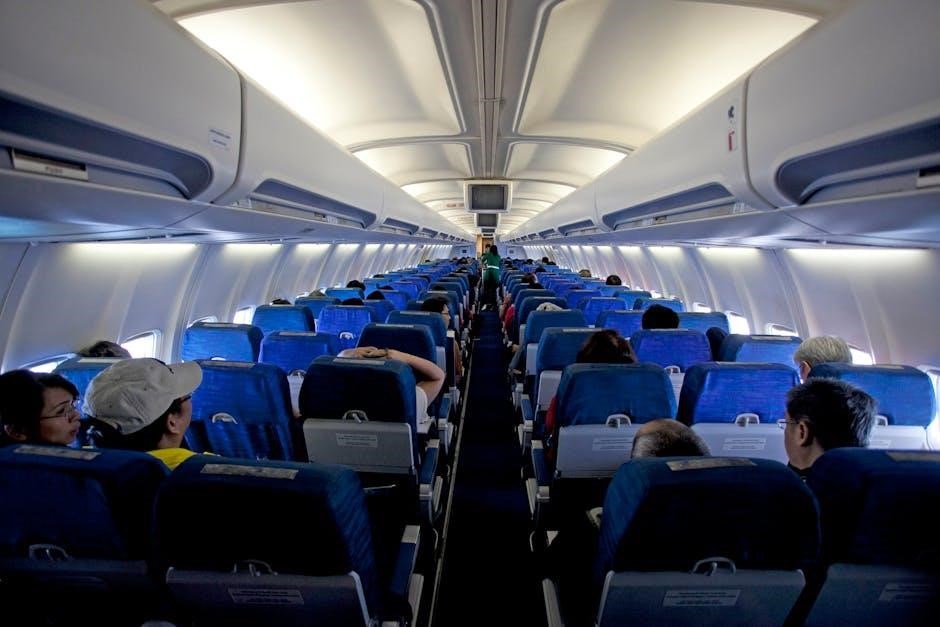A pre-trip inspection is a critical process for Class A vehicles‚ ensuring safety and compliance. It involves checking the truck‚ trailer‚ and coupling systems for leaks‚ leans‚ and proper functionality of lights and brakes. This step is essential for identifying potential issues before hitting the road‚ preventing accidents‚ and meeting legal requirements. Regular inspections also help maintain vehicle reliability and reduce the risk of mechanical failures during operation. By following a structured checklist‚ drivers can systematically evaluate their vehicle’s condition‚ ensuring everything is in working order prior to departure.

1.1 Importance of Pre-Trip Inspections
The importance of pre-trip inspections for Class A vehicles cannot be overstated. These inspections are essential for ensuring the safety of the driver‚ passengers‚ and other road users. By identifying potential mechanical issues before departure‚ drivers can prevent breakdowns and accidents. Pre-trip inspections also help comply with legal requirements‚ avoiding penalties and delays. Regular checks promote vehicle longevity‚ reducing maintenance costs over time. Additionally‚ they demonstrate professionalism and responsibility‚ fostering a culture of safety within the transportation industry. Conducting thorough inspections ensures that all systems‚ such as brakes‚ tires‚ and lights‚ are functioning properly‚ which is critical for safe operation. This practice not only safeguards lives but also protects cargo and prevents costly disruptions. Overall‚ pre-trip inspections are a cornerstone of responsible and efficient commercial driving.
1.2 Purpose of a Pre-Trip Inspection
The primary purpose of a pre-trip inspection is to ensure that a Class A vehicle is safe to operate and roadworthy. It serves as a proactive measure to identify and address any potential mechanical issues before they lead to accidents or breakdowns. The inspection process involves checking critical components such as the engine‚ brakes‚ tires‚ lights‚ and coupling systems. This ensures that all parts are in proper working condition and meet legal standards. Additionally‚ the inspection helps drivers familiarize themselves with their vehicle‚ fostering a better understanding of its operational state. By systematically evaluating each component‚ drivers can confidently operate their vehicle‚ knowing they have taken comprehensive steps to ensure safety. The ultimate goal is to minimize risks‚ enhance operational efficiency‚ and comply with regulatory requirements‚ thereby contributing to a safer and more reliable transportation system.
1.3 Legal Requirements for Class A Vehicles
Class A vehicles are subject to stringent legal requirements for pre-trip inspections‚ primarily governed by the Federal Motor Carrier Safety Administration (FMCSA) regulations. Drivers must conduct a thorough inspection before each trip‚ covering critical systems such as brakes‚ tires‚ lights‚ and coupling devices. The inspection must be documented using a standardized checklist‚ ensuring compliance with federal and state laws. Failure to perform or document the inspection can result in penalties‚ fines‚ or even operational shutdowns. These regulations aim to enhance road safety by ensuring all commercial vehicles are mechanically sound and operated safely. Adherence to these legal standards is not only a regulatory obligation but also a vital practice for protecting public safety and minimizing liability risks for carriers and drivers alike. By following these requirements‚ Class A vehicle operators contribute to a safer and more compliant transportation industry.

The Pre-Trip Inspection Process
The pre-trip inspection process involves checking the exterior for leaks and leans‚ inspecting the interior‚ evaluating the engine compartment‚ and examining coupling systems and trailers to ensure all components are in proper working order.
2.1 Exterior Inspection
The exterior inspection is a crucial step in the pre-trip process for Class A vehicles. It begins with checking for any visible leaks under the engine and around the wheels‚ ensuring there are no signs of fluid loss. Next‚ the driver assesses whether the vehicle is leaning to one side‚ which could indicate an issue with the suspension or tire pressure. The lights and signals are then examined to ensure all are functioning correctly‚ including brake lights‚ turn signals‚ and hazard lights. Additionally‚ the overall condition of the truck and trailer is evaluated‚ noting any damage or wear that could affect safety. This thorough exterior check helps identify potential issues before they escalate‚ ensuring the vehicle is roadworthy and compliant with regulations.
2.2 Interior Inspection
The interior inspection focuses on the driver’s compartment and essential systems within the cab. Begin by checking the condition of the seat belts‚ ensuring they are functional and free from damage. Adjust the mirrors and seats for proper visibility and comfort. Inspect the dashboard gauges‚ including the air pressure‚ oil pressure‚ and temperature indicators‚ to ensure they are within normal ranges. Test the steering wheel for proper alignment and responsiveness. Check the parking brake and clutch or accelerator pedals for smooth operation. Ensure all warning lights are off and the low air pressure warning system is functioning correctly. For Class A vehicles‚ the air brakes must not lose more than 4psi in one minute during this check. This step ensures the interior systems are safe and ready for operation‚ providing the driver with a reliable environment to control the vehicle effectively.

2.3 Engine Compartment Check
The engine compartment check is a vital part of the pre-trip inspection for Class A vehicles. Begin by opening the hood and visually inspecting for any signs of leaks‚ such as oil‚ coolant‚ or fuel drips‚ which could indicate worn gaskets or hoses. Check the coolant level in the radiator and ensure it is within the recommended range to prevent overheating. Inspect the belts for cracks‚ frays‚ or excessive wear‚ and verify that they are properly tensioned to avoid failure during operation. Examine the hoses for soft spots‚ bulges‚ or leaks‚ which could lead to system failures. Look at the air filter for cleanliness and ensure it is securely fastened to maintain proper engine airflow. Also‚ check the battery terminals for corrosion and ensure they are tightly connected. This thorough inspection helps identify potential issues early‚ preventing costly repairs and ensuring the engine runs smoothly during the trip.
2.4 Coupling Systems Inspection
The coupling systems inspection is essential to ensure the secure connection between the tractor and trailer. Start by checking the fifth wheel‚ ensuring it is properly lubricated and free from debris. Verify that the fifth wheel jaw is fully closed and locked around the kingpin‚ with no visible gaps. Inspect the kingpin for damage or wear‚ as a faulty kingpin can compromise the coupling. Next‚ examine the glad hands and air hoses for any signs of leaks or damage‚ ensuring they are securely connected to the trailer. Check the trailer’s height to confirm it is aligned with the tractor’s fifth wheel for proper coupling. Finally‚ inspect the safety chains‚ making sure they are properly attached to both the tractor and trailer‚ with no signs of rust or damage. This ensures the trailer remains securely attached even in case of a coupling failure‚ enhancing overall safety during operation.
2.5 Trailer Inspection
The trailer inspection involves a thorough check of its structural integrity and operational components. Start by examining the trailer frame‚ cross-members‚ and sides for any signs of damage‚ rust‚ or wear. Ensure the roof and doors are secure and properly closed. Check the wheels and tires for proper inflation‚ uneven wear‚ and damage to the rims. Inspect the landing gear to confirm it is fully raised‚ stable‚ and free from damage. Verify that all wiring and electrical connections between the tractor and trailer are secure and not damaged. Test the trailer’s brake lights‚ turn signals‚ and tail lights to ensure they are functioning correctly. For trailers equipped with ABS systems‚ check the ABS lights for any fault indicators. Finally‚ ensure the trailer is clean and free of debris‚ with functional mud flaps and secure cargo tie-downs if applicable. This ensures the trailer is safe and ready for operation.

Specific Checks During the Inspection
Inspect for leaks under the engine‚ check for vehicle leans‚ and verify lights and signals functionality. Ensure tires are properly inflated‚ brakes function correctly‚ and suspension systems are stable. Address any defects promptly.
3.1 Checking for Leaks
Checking for leaks is a vital part of a pre-trip inspection for Class A vehicles; Drivers should inspect the ground under the engine and around hoses for signs of fluid leaks‚ such as coolant‚ oil‚ or hydraulic fluid. Leaks can indicate worn seals‚ loose connections‚ or damaged components‚ which may lead to mechanical failures. It’s important to visually examine all hoses‚ fittings‚ and seals for any cracks‚ frays‚ or drips. Additionally‚ ensure there are no puddles or stains under the vehicle‚ as these can signal potential issues. Addressing leaks early helps prevent breakdowns and ensures the vehicle remains safe and operational. This step is critical for maintaining roadworthiness and complying with safety regulations. Always document any leaks found and report them for repair before driving.
3.2 Assessing Leans
Assessing leans is a crucial step in the pre-trip inspection process for Class A vehicles. Drivers must check if the vehicle is leaning to one side‚ which could indicate uneven weight distribution‚ suspension issues‚ or air leakage in the suspension system. To do this‚ walk around the vehicle and visually inspect its stance. Ensure the trailer and tractor are properly aligned and that the load is evenly distributed. If the vehicle appears to lean‚ investigate further by checking the suspension components‚ air bags‚ or springs for damage or leaks. A leaning vehicle can affect handling and safety on the road‚ so addressing this issue is essential. Always document any discrepancies and have them corrected before operating the vehicle. This step helps prevent potential hazards and ensures a stable‚ safe driving experience. Regular checks also contribute to maintaining the vehicle’s overall condition and compliance with safety standards.
3.3 Inspecting Lights and Signals

Inspecting lights and signals is a vital part of the pre-trip inspection for Class A vehicles. Drivers must ensure all lights are functional to maintain visibility and communicate intentions to other road users. This includes checking brake lights‚ turn signals‚ hazard lights‚ and marker lights. Start by turning on the ignition and testing each light individually. Walk around the vehicle to verify that all lights illuminate correctly and are free from damage or obstruction. Pay special attention to the trailer lights‚ ensuring they are properly connected and functioning in sync with the tractor. Clean any dirt or debris that could reduce light visibility. Also‚ check that all signals are synchronized and that no bulbs are burned out. Properly functioning lights are essential for safety and legal compliance. Any issues found should be documented and repaired before operation to prevent potential hazards and ensure clear communication on the road.
3.4 Tire and Wheel Inspection
The tire and wheel inspection is a critical component of a Class A pre-trip inspection. Drivers must check for proper tire inflation‚ signs of wear‚ and any damage. Start by walking around the vehicle to visually inspect all tires‚ including the spare‚ for uneven wear‚ cracks‚ or punctures. Ensure tire pressure matches the manufacturer’s specifications‚ as under-inflated tires can lead to reduced fuel efficiency and increased risk of blowouts. Check the tread depth using a gauge‚ ensuring it meets legal standards. Inspect the wheels for looseness‚ damage‚ or missing nuts‚ and verify that all valve caps are securely in place. Also‚ look for any signs of leakage around the valve stems. Properly maintained tires and wheels are essential for vehicle stability‚ braking performance‚ and overall safety on the road. Any defects should be documented and addressed before operation to prevent potential hazards during transit.
3.5 Brake System Check
The brake system check is a vital part of a Class A pre-trip inspection‚ ensuring the vehicle can stop safely and effectively. Begin by inspecting the brake pads and rotors for wear‚ damage‚ or excessive corrosion. Check the brake shoes for proper alignment and ensure they are not worn down beyond the manufacturer’s recommended limit. Hydraulic systems require checking fluid levels and looking for signs of leaks around hoses‚ connections‚ and cylinders. For air-brake equipped vehicles‚ perform a low-pressure test by turning the key without starting the engine and pressing the brake pedal to ensure the pressure drops correctly. Also‚ test the emergency brake system to confirm it holds the vehicle in place. Any issues‚ such as spongy brakes‚ unusual noises‚ or fluid leaks‚ must be documented and repaired immediately. A functioning brake system is crucial for preventing accidents and ensuring compliance with safety regulations during operation.

3.6 Suspension and Steering Inspection
The suspension and steering system inspection ensures the vehicle maintains stability and control while driving. Start by visually inspecting the suspension components‚ including springs‚ shock absorbers‚ and air bags‚ for signs of damage‚ leaks‚ or excessive wear. Check the torque rods‚ U-bolts‚ and spring hangers for proper tightness and alignment. For the steering system‚ inspect the steering box‚ Pitman arm‚ and tie rods for any damage or play. Test the steering wheel for excessive free play or unusual resistance. Ensure the wheels are properly aligned and the tires are not pulling to one side. Also‚ check the power steering fluid level and look for leaks around the steering gear box. Any issues in these areas can lead to poor handling‚ reduced safety‚ and increased risk of mechanical failure. Properly functioning suspension and steering systems are essential for maintaining control of the vehicle‚ especially at high speeds or during sharp turns.

Documentation and Reporting
Documentation is crucial for maintaining records of pre-trip inspections. Drivers must use a checklist to mark completed items and note any defects. This process ensures compliance and provides a clear record of vehicle condition.
4.1 Using a Pre-Trip Inspection Checklist
A pre-trip inspection checklist is a vital tool for ensuring a thorough and systematic evaluation of a Class A vehicle. It typically includes sections for the engine compartment‚ coupling systems‚ trailer‚ and exterior features like lights and tires. Drivers are required to use this checklist during the CDL pre-trip inspection test to demonstrate their ability to identify safety issues. The checklist allows drivers to mark off each item as they inspect it‚ ensuring no critical components are overlooked. It is important to follow the checklist carefully‚ as it is designed to cover all essential aspects of the vehicle’s safety and operational readiness. While the checklist is not a substitute for daily inspections‚ it provides a standardized method for verifying that the vehicle is safe to operate. Proper use of the checklist helps drivers comply with regulations and ensures a smooth inspection process during the test.
4.2 Recording Defects and Issues
Accurate and detailed recording of defects and issues is a critical step in the pre-trip inspection process for Class A vehicles. Drivers must document any defects or abnormalities found during the inspection to ensure compliance with safety regulations and to provide a clear record for maintenance personnel. This documentation should include specific details about the nature and location of the issue‚ as well as any potential safety risks. The checklist serves as a valuable tool for recording these findings‚ allowing drivers to systematically note each defect. It is important to be thorough‚ as incomplete or inaccurate records can lead to legal consequences and operational delays. Once defects are recorded‚ they must be addressed by qualified mechanics before the vehicle is deemed safe for operation. Proper documentation not only enhances safety but also demonstrates adherence to regulatory requirements and professional standards.

Regulations and Best Practices
Compliance with FMCSA guidelines is essential for Class A vehicles. Drivers must adhere to federal and state-specific regulations‚ ensuring all inspections align with legal standards. Following established best practices enhances safety and operational efficiency.
5.1 FMCSA Guidelines for Pre-Trip Inspections
The Federal Motor Carrier Safety Administration (FMCSA) mandates specific guidelines for pre-trip inspections of Class A vehicles to ensure road safety. Drivers must inspect critical components such as brakes‚ tires‚ lights‚ and coupling systems. The FMCSA requires checking for leaks‚ proper vehicle alignment‚ and functional signaling devices. Brake systems must be tested by depressing the pedal to ensure air pressure does not drop excessively. Tires and wheels should be inspected for wear‚ damage‚ or inflation issues. Lighting and reflectors must be clean and operational. The coupling system between the tractor and trailer must be secure and functioning correctly. These guidelines are enforced to minimize mechanical failures and reduce accident risks. Non-compliance can result in violations‚ fines‚ or even operational shutdowns. Adhering to FMCSA standards is crucial for maintaining legal compliance and ensuring the safety of both the driver and other road users.
5.2 State-Specific Variations
While the FMCSA sets federal guidelines‚ individual states may impose additional or varying requirements for pre-trip inspections of Class A vehicles. These variations often reflect regional conditions or specific safety concerns. For instance‚ some states may require more frequent inspections or have additional checklists for certain components. California‚ for example‚ has strict emissions standards that may necessitate extra checks. Texas‚ given its extensive highways‚ might emphasize tire inspections due to high temperatures and heavy loads. Other states could focus on lighting systems to accommodate low-visibility conditions. Drivers must familiarize themselves with local regulations to avoid citations. These state-specific rules ensure adherence to both federal and regional safety standards‚ promoting a uniform level of safety across all jurisdictions. Understanding these variations is crucial for compliance and seamless operations when crossing state lines. Staying informed helps drivers navigate the complexities of varying requirements efficiently.

5.3 Driver Responsibilities
Drivers play a crucial role in ensuring the safety and legality of their Class A vehicles through pre-trip inspections. They are responsible for conducting thorough inspections‚ using checklists to verify that all critical components are in proper working condition. This includes checking for leaks‚ ensuring the vehicle is not leaning‚ and verifying that all lights and signals are functioning correctly. Drivers must also inspect tires‚ brakes‚ and suspension systems to guarantee the vehicle is roadworthy. Any defects or issues identified during the inspection must be documented and reported to the appropriate authorities or maintenance team. Additionally‚ drivers are accountable for ensuring their vehicle complies with both federal and state-specific regulations. By fulfilling these responsibilities‚ drivers contribute significantly to road safety and legal compliance. Their diligence helps prevent potential hazards and ensures smooth operations during transit. Regular adherence to these duties is essential for maintaining a safe and efficient transportation process.
